
Hands-On Electronics was an electronics hobbyist magazine published by Gernsback Publications in the United States from 1980 to 1989. [1]

Hands-On Electronics was an electronics hobbyist magazine published by Gernsback Publications in the United States from 1980 to 1989. [1]
The magazine started as Radio-Electronics Special Projects in 1980. [1] This was nominally a quarterly supplement to Radio-Electronics that had 10 issues from a single 1980 issue to the Spring 1984 issue. The Summer 1984 issue was renamed Hands-On Electronics. [1] It became bi-monthly in January 1986 and monthly in November 1986. The title was changed to Popular Electronics in February 1989 and was published until December 1999. The longtime Radio Electronics editor, Larry Steckler, was the publisher and owner. (Having purchased Gernsback Publications from the Gernsback family.) Julian S. Martin was the editor.
The early issues were just a collection of construction projects. By 1984 there were monthly columns on shortwave listening, amateur radio, and computers. After Ziff-Davis changed Popular Electronics to Computers & Electronics , Hands-On Electronics attracted those hobbyist readers. In April 1985 Ziff-Davis stopped publishing Computers & Electronics and Hands-On Electronics purchased the title in June 1988. The magazine became monthly and added the Popular Electronics logo to the cover in November 1988. In February 1989 the magazine was published with the name Popular Electronics. [1]

Hugo Gernsback was an American editor and magazine publisher whose publications included the first science fiction magazine, Amazing Stories. His contributions to the genre as publisher were so significant that, along with the novelists Jules Verne and H. G. Wells, he is sometimes called "The Father of Science Fiction". In his honor, annual awards presented at the World Science Fiction Convention are named the "Hugos".
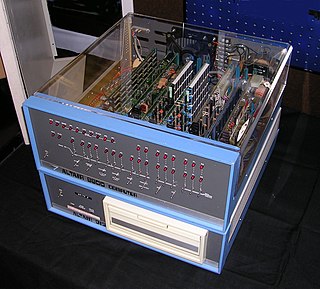
The Altair 8800 is a microcomputer designed in 1974 by MITS and based on the Intel 8080 CPU. Interest grew quickly after it was featured on the cover of the January 1975 issue of Popular Electronics and was sold by mail order through advertisements there, in Radio-Electronics, and in other hobbyist magazines. According to Harry Garland, the Altair 8800 was the product that catalyzed the microcomputer revolution of the 1970s. It was the first commercially successful personal computer. The computer bus designed for the Altair was to become a de facto standard in the form of the S-100 bus, and the first programming language for the machine was Microsoft's founding product, Altair BASIC.

Amazing Stories is an American science fiction magazine launched in April 1926 by Hugo Gernsback's Experimenter Publishing. It was the first magazine devoted solely to science fiction. Science fiction stories had made regular appearances in other magazines, including some published by Gernsback, but Amazing helped define and launch a new genre of pulp fiction.

Ziff Davis, Inc. is an American digital media and internet company. Founded in 1927 by William Bernard Ziff Sr. and Bernard George Davis, the company primarily owns technology- and health-oriented media websites, online shopping-related services, internet connectivity services, gaming and entertainment brands, and cybersecurity and martech tools. Previously, the company was predominantly a publisher of hobbyist magazines.
Micro Instrumentation and Telemetry Systems (MITS) was an American electronics company founded in Albuquerque, New Mexico that began manufacturing electronic calculators in 1971 and personal computers in 1975.

Computer Gaming World (CGW) was an American computer game magazine published between 1981 and 2006. One of the few magazines of the era to survive the video game crash of 1983, it was sold to Ziff Davis in 1993. It expanded greatly through the 1990s and became one of the largest dedicated video game magazines, reaching around 500 pages by 1997.
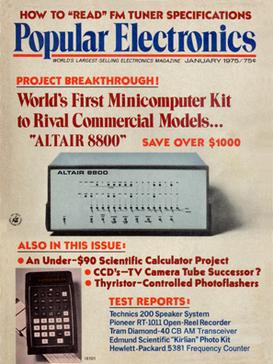
Popular Electronics was an American magazine published by John August Media, LLC, and hosted at TechnicaCuriosa.com. The magazine was started by Ziff-Davis Publishing Company in October 1954 for electronics hobbyists and experimenters. It soon became the "World's Largest-Selling Electronics Magazine". In April 1957, Ziff-Davis reported an average net paid circulation of 240,151 copies. Popular Electronics was published until October 1982 when, in November 1982, Ziff-Davis launched a successor magazine, Computers & Electronics. During its last year of publication by Ziff-Davis, Popular Electronics reported an average monthly circulation of 409,344 copies. The title was sold to Gernsback Publications, and their Hands-On Electronics magazine was renamed to Popular Electronics in February 1989, and published until December 1999. The Popular Electronics trademark was then acquired by John August Media, who revived the magazine, the digital edition of which is hosted at TechnicaCuriosa.com, along with sister titles, Mechanix Illustrated and Popular Astronomy.

PC Magazine is an American computer magazine published by Ziff Davis. A print edition was published from 1982 to January 2009. Publication of online editions started in late 1994 and continues as of 2024.

Forrest M. Mims III is an American amateur scientist, magazine columnist, and author of Getting Started in Electronics and Engineer's Mini-Notebook series of instructional books that were originally sold in Radio Shack electronics stores and are still in print. Mims graduated from Texas A&M University in 1966 with a major in government and minors in English and history. He became a commissioned officer in the United States Air Force, served in Vietnam as an Air Force intelligence officer (1967), and a Development Engineer at the Air Force Weapons Laboratory (1968–70).
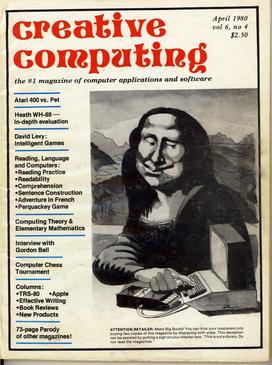
Creative Computing was one of the earliest magazines covering the microcomputer revolution. Published from October 1974 until December 1985, the magazine covered the spectrum of hobbyist/home/personal computing in a more accessible format than the rather technically oriented Byte.

Henry EdwardRoberts was an American engineer, entrepreneur and medical doctor who invented the first commercially successful personal computer in 1974. He is most often known as "the father of the personal computer." He founded Micro Instrumentation and Telemetry Systems (MITS) in 1970 to sell electronics kits to model rocketry hobbyists, but the first successful product was an electronic calculator kit that was featured on the cover of the November 1971 issue of Popular Electronics. The calculators were very successful and sales topped one million dollars in 1973. A brutal calculator price war left the company deeply in debt by 1974. Roberts then developed the Altair 8800 personal computer that used the new Intel 8080 microprocessor. This was featured on the cover of the January 1975 issue of Popular Electronics, and hobbyists flooded MITS with orders for this $397 computer kit.

Daniel Meyer was the founder and president Southwest Technical Products Corporation. He was born in New Braunfels, Texas, and raised in San Marcos, Texas, where he earned a bachelor's degree in mathematics and physics in 1957 from Southwest Texas State. After college he married Helen Wentz, moved to San Antonio and became a research engineer in the electrical engineering department of Southwest Research Institute.
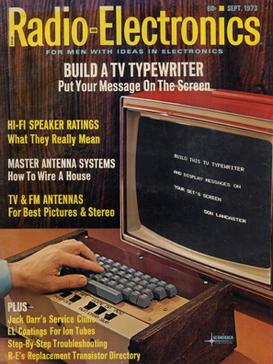
The TV Typewriter is a video terminal that could display two pages of 16 lines of 32 upper case characters on a standard television set. The design, by Don Lancaster, appeared on the cover of Radio-Electronics magazine in September 1973.
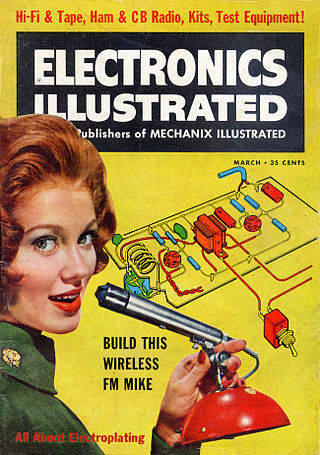
Electronics Illustrated was an American magazine started in May 1958 by Fawcett Publications, the publishers of Mechanix Illustrated. The magazine was published monthly from 1959 to 1961 then bi-monthly until November 1972. Charles Tepfer was the first editor and Robert Beason was the editor for rest of the magazine's run. The headquarters was in Greenwich, Connecticut.

Experimenter Publishing was an American media company founded by Hugo Gernsback in 1915. The first magazine was The Electrical Experimenter (1913–1931) and the most notable magazines were Radio News (1919–1985) and Amazing Stories (1926–2005). Their radio station, WRNY, began broadcasting experimental television in 1928. In early 1929 the company was forced into bankruptcy and the Gernsback brothers lost control of Experimenter Publishing. The magazines did not miss an issue and were quickly sold to another publisher. The Gernsbacks promptly started new magazines to compete with their former ones.
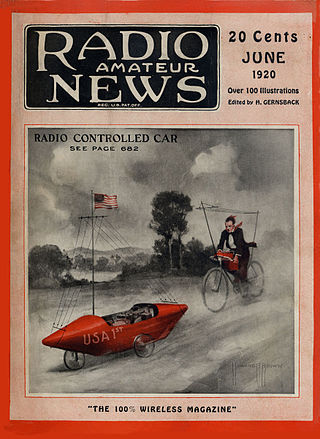
Radio News was an American monthly technology magazine published from 1919 to 1971. The magazine was started by Hugo Gernsback as a magazine for amateur radio enthusiasts, but it evolved to cover all the technical aspects to radio and electronics. In 1929, a bankruptcy forced the sale of Gernsback's publishing company to B. A. Mackinnon. In 1938, Ziff-Davis Publishing acquired the magazines.
Electronics Australia or EA was Australia's longest-running general electronics magazine. It was based in Chippendale, New South Wales.
Electronics World is a technical magazine in electronics and RF engineering aimed at professional design engineers. It is produced monthly in print and digital formats.

Radio-Electronics was an American electronics magazine that was published under various titles from 1929 to 2003. Hugo Gernsback, sometimes called the father of science fiction, started it as Radio-Craft in July 1929. The title was changed to Radio-Electronics in October 1948 and again to Electronics Now in July 1992. In January 2000 it was merged with Gernsback's Popular Electronics to become Poptronics. Gernsback Publications ceased operations in December 2002 and the January 2003 issue was the last. Over the years, Radio-Electronics featured audio, radio, television and computer technology. The most notable articles were the TV Typewriter and the Mark-8 computer. These two issues are considered milestones in the home computer revolution.

Martin Research Ltd., later Qwint Systems, Inc., was an American computer company founded by Donald Paul Martin in Northbrook, Illinois, United States. The company released their Mike family of modular kit microcomputers starting in 1975. These computers, spanning several models based on the Intel 8008, 8080, and Zilog Z80 microprocessors, proved very popular among hobbyists who wanted an inexpensive trainer computer.
Archived Hands On Electronics magazines on the Internet Archive